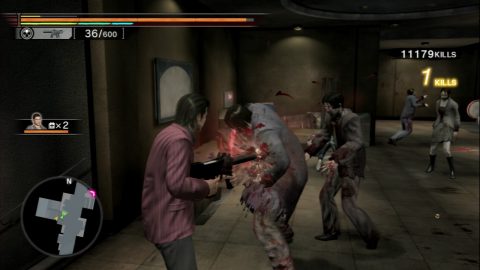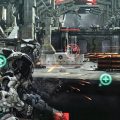It took nearly two years and near cancellation, but Sega finally managed to get the long-awaited Yakuza spin-off to shelves. Bearing the subtitle Of the End in Japan, this entry of the series has you not fighting random thugs, but blasting your way through hordes of zombies in a quarantined Kamurocho, as the Tojo Clan tries to get to the bottom of why their family offices are being attacked by a familiar-looking zombie, and Japan’s Self-Defense Force struggles to keep the infection under lockdown. Your playable characters this time around are Yakuza 4’s loan shark with a heart of gold, Shun Akiyama; Yakuza 2’s nemesis Ryuji Goda, expelled from his clan and sporting a prosthetic arm that transforms into a gatling gun; Goro Majima in his playable character debut, wielding an automatic shotgun with which he indulges his zombie-movie fantasies; and Kazuma Kiryu, who is here to rescue Haruka, but will have to grapple with the cause of the infestation in the process.
Since you’re fighting hordes of the undead, and not other humans, the rules of engagement have changed quite a bit. Gone is the usual melee combat. It has been replaced with a decent arsenal of firearms and grenades. You can still kick the zombies, but there are no combo attacks or Heat finishers. The real star of the game would be the guns: pistols, shotguns, SMGs, assault rifles, sniper rifles, grenade launchers, and miniguns. Like the previous two games, you can upgrade these guns by speaking to Kamiyama in his conveniently placed weapons van. Beyond the guns, you can also use emplaced weapons on vehicles, such as mounted machine guns on Jeeps, a tank turret, or a pitching machine, with which you can fire baseballs or any grenades you might have in your pocket. Ammunition is not often a concern, as stashes littered around the quarantine zone frequently contain more ammo than you’ll use in a given expedition, unless you’re delving down into the roguelite-esque underground tunnels.
The zombie-killing gameplay may feel a bit bland compared to Yakuza’s traditional street brawls, if not for the fact that you can still pick up bicycles and street signs and bash zombies around with them. It feels a bit like the first Dead Rising, in a way, even down to the controls. Your character will auto-aim towards the nearest zombie that he’s facing, under most circumstances. You can hold a button to strafe, which makes the controls behave a bit like an old-school Ikari Warriors or Heavy Barrel-like commando game, or you can hold another button to go into an over-the-shoulder aiming mode, which renders you unable to move, as in Resident Evil 4 or 5. The Japanese version’s control layout has the fire button mapped to Square, but Sega added a second control layout to the US release which moves it to the R1 button instead, making it a bit less fiddly. (The Japanese layout is still available as an option.)
There are a number of environmental hazards that you can use to your advantage through this game’s alternate Heat system, called Heat Sniping. When your Heat gauge is maxed out, you can press Triangle to enter slow-motion, where your character will focus on destructible targets such as gas cylinders, fire hydrants, bundles of steel girders, oil drums, car fuel tanks, and other volatile objects. Once you choose a target, you will see the bullets approach it in slow motion, and you must pass a quick-time event, or your bullets will just ricochet off their target. In theory this is supposed to be great for defeating large groups of enemies, but in practice, it feels random and imprecise whether it will affect the targets you actually wanted it to, or whether the game will consider nobody near enough to take the damage. If not for the fact that there is nothing else to use your Heat gauge on in this game, it almost wouldn’t be worth bothering with; the Heat snipes just seem to take too long, really dragging down the pacing of the game.
In addition to the common zombies that go down in a couple of bullets each, there are several “unique” types, similar to games like Left 4 Dead and Killing Floor. Cry Babies are mutated hostesses that will scream and run away from you, summoning more zombies in the process. Meatheads can only be damaged with head shots, but their slow, lumbering movements make them easy targets from a distance. Fatties are near-identical clones of L4D’s Boomer, in that killing them spreads pheromones that drive nearby zombies berserk. Monkey Boys, clad in knee pads and bike helmets, are really fast and will try to overwhelm you by quite literally running circles around you. Aggros, punk-like street fighters in white hoodies, ordinarily ignore you, but if you damage them, they will rush you and can actually do some serious damage unless you can stun-lock them with a rapid-fire weapon, or have a partner on hand to draw their attention. The staple Yakuza boss fights come in the form of Prototypes, giant mutants which take quite a lot more firepower to kill, and often involve some sort of gimmick. The boss fights are really where this gameplay falls flat, since a number of them are only vulnerable if shot in specific areas of the body (typically, glowy orange bits), which requires the player to stop moving and use the aim button to hit them, since auto-aim doesn’t target these areas.
This being a Yakuza game, there is still RPG-like character progression, but unlike every other game in the series, there is only one core set of stats and skills to unlock. Every playable character shares the same experience level and learned skills, so you aren’t resetting to zero every time you progress the storyline, but this does also mean that everybody more or less plays the same, outside of their signature weapons and exclusive partners. Leveling up grants you Soul Orbs, as in Yakuza 4 and 5, but the skills this time range from expanded inventory limits to stronger auto-aiming and faster movement speeds. There is still a training course you can take, with returning minor character Gary Buster Holmes acting as your drill instructor, but this is more for the benefit of your AI buddies than for you.
Outside of the zombies, this installment is laid out pretty similarly to the rest of the series. When you aren’t in the Quarantine Zone, you can run around Kamurocho, visit the shops, talk to people, get substories, enter hostess clubs, and other such things. Although progressing the story does expand the Quarantine Zone to encompass nearly all of Kamurocho by the end of the game, you can still enter and use the shops – you just need to fight the zombies away from them first. The hostess clubs Jewel and Shine are still in business, and you can visit them even during lockdown and meet the new girls. Club Sega is even miraculously still operating, and Kiryu is also able to take a taxi back to Okinawa to play golf for no particular reason.
And of course, the series’ usual array of substories is here in full force. Most substories are triggered outside of the Quarantine, but inevitably require you to go inside to rescue someone. The usual writing style appears here in spades, with strong nods toward the fans, and with a particular shine on how, despite everything, Kamurocho’s citizens will all still try to operate as they always do. Akiyama tries to track down his clients amid the flames and the scourge, Majima indulges his zombie movie genre-savviness by dressing his boss up in drag, Ryuji attempts to tie up his own loose ends after the however-many years since his last game, and Kiryu discovers that, even during the zombie apocalypse, scammers will be scammers. Fans of the series’ usual tonal whiplash will find a lot to love here.
If Yakuza: Dead Souls has a target audience, it is primarily for the series’ existing fanbase. The game thrives on its self-referential gags and character driven writing, with some of the wackiest substories to be found in the series to that point. What ultimately drags it away from being a truly great game is the somewhat awkward action gameplay. Shooting feels mostly okay, but the slowdown is quite drastic in parts, as if the poor PlayStation 3 cannot keep up with all of these hordes and fire effects. Still, though, this isn’t to say that the game is completely unplayable, just that players should temper their expectations. Dead Rising, this is not.
This game’s release was originally set for March of 2011 in Japan, but its original release date unfortunately ended up coinciding with the Fukushima earthquake that same month, so Sega announced that the game’s release would be put on indefinite hiatus. The game was eventually released in Japan three months later, in June. The US release finally hit store shelves on the 13th of March 2012; it, unfortunately, failed to meet sales or critical expectations, and for almost three years, seemed as if it had ruined the chances of any further entries being localized to English. It is, as yet, constrained to PlayStation 3, with no evident plans for a re-release or remaster.
It isn’t hard to look at Dead Souls as a failed experiment, or a pessimistic late-comer to the exhausting zombie-game fad of the PS3 generation. To ignore the game on these merits is to ignore some of this series’ most memorable writing. All things considered, this is still a game for the fans; the rest of the series continues to reference Dead Souls as well, with zombie-themed substories to be found in Yakuza 5, 0, and Kiwami. It might not be canon, but the series won’t pretend it didn’t happen, either.


